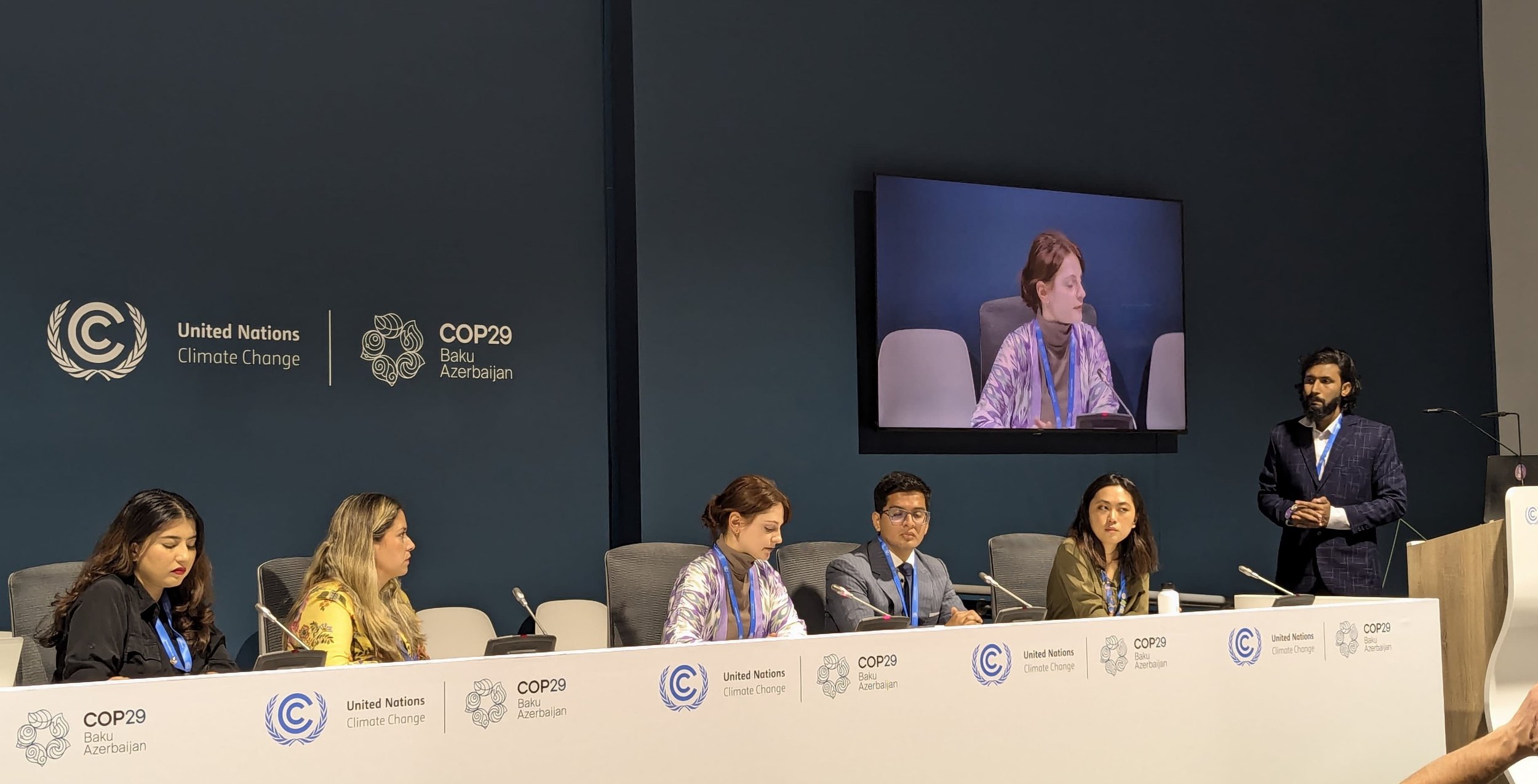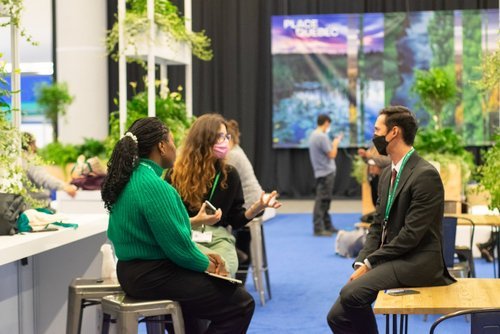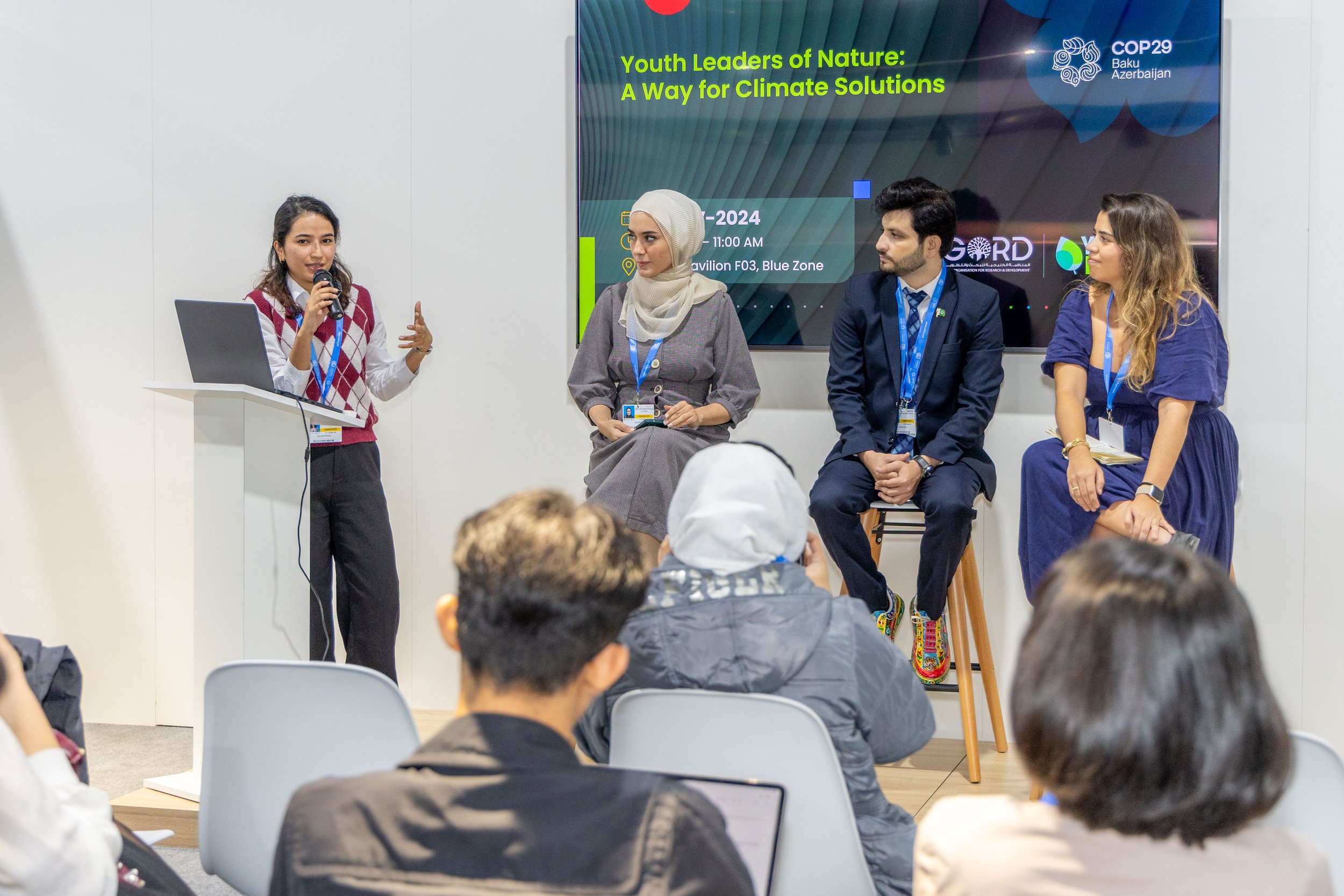This blog was written and produced by Ashik Iqbal and Asmita Rawat
COPs are important platforms for shaping global climate and biodiversity policies that more and more people seek to engage in each year. At Youth4Nature, we know firsthand that these high-level spaces can be overwhelming due to the sheer scale, technical nature, and complex processes.
In this blog, we have put together some key information coupled with our personal experiences to share basic knowledge, practical tips, and reflections that can help youth leaders have clearer and more concrete preparation, best utilise their COP journey, and contribute to the action meaningfully!
Understanding COP
COP stands for Conference of the Parties. Emerging from the 1992 Rio Earth Summit, COPs are meetings that occur under three major conventions:
The UN Framework Convention on Climate Change (UNFCCC)
The UN Convention on Biological Diversity (UNCBD)
UNCBD and UNCCD COPs happen once every two years, and UNFCCC COP is held annually.
These conferences bring together all the parties (i.e., countries that have agreed to the Conventions), organisations, and civil society to negotiate and take decisions to promote the effective implementation of the Conventions, including institutional and administrative arrangements [2]. What does this look like in practice? Well, here is what normally happens at a COP:
Reviewing progress towards the overall goal of the Conventions,
Sometimes creating new agreements and treaties, often refining targets, agreeing on rules, or forming binding treaties (like the Kyoto Protocol, Paris Agreement, the Kunming-Montreal Global Biodiversity Framework!)
Reviewing the contributions of each of the parties [3]
🌱 Subsidiary Bodies (SBs) session
Let’s focus on UNFCCC for a moment! The UNFCCC SBs meet twice a year, once during the Bonn Climate Change Conference in June, and at COP itself. There are two SB groups:
The Subsidiary Body for Implementation (SBI) focuses on the implementation of climate policies and actions
The Subsidiary Body for Scientific and Technological Advice (SBSTA) provides scientific and technological advice for implementing the Paris Agreement and other climate policy processes
SB sessions are very technical and negotiation/framework-oriented. The SBs play a vital role in preparing the agenda for the COP, providing technical expertise and recommendations that shape the negotiations and outcomes of the COP [4]. To make an impact at COP, it is important to start preparing from the SB sessions.
🌱 Who is at COP, and what are their roles?
The participants at a COP are representatives of three main groups:
parties (country government delegations),
observers (including civil society groups, researchers, businesses, financial institutions, local community organizations, and youth), and
media (journalists)
Parties are the main decision-makers who negotiate and adopt global climate agreements, representing their national interests through official delegations. COP also provides space for other relevant stakeholder to foster their climate actions. Observers play important roles in influencing negotiations (made by parties) through advocacy, side events, and action events.
Beyond formal negotiations, COP can be a space for bilateral meetings, side events at the pavilions, and press conferences, providing numerous opportunities for engagement and influence. Pavilions - which can be hosted by countries, groups of countries, and observer organisations - are dedicated spaces within the venue that are used to host side events, showcase research and expertise, and have open informal discussions with all COP participants that visit the Pavilion [5]. Civil society groups, researchers, financial institutions, and youth offer side events at different pavilions to facilitate information sharing, contributing to capacity building through training and knowledge exchange, and raising public awareness [6]. Observers can also monitor the parties’ actions, acting as a watchdog and contributing to the transparency and inclusivity of the negotiations [7].
🌱 Youth Participation
Globally, young generations are reshaping the negotiations by pushing for action and implementation, amplifying the message of vulnerable communities, and making a fair case for climate justice and intergenerational equity. Awareness raising, knowledge sharing, capacity building, collaboration, cooperation and networking, lobbying and advocacy, and youth actions are just some avenues for youth participation at COP. Youth have become a powerful force within COP, often acting as a pressure group to demand urgent and ambitious action through their activism, lobbying, and direct interventions [8]. Beyond activism, youth contribute through research, policy analysis & position papers, and media representation, ensuring that solutions are innovative, inclusive, fit-for-purpose, and science-driven.
🌱 Green Zone and Blue Zone
Each Conference of the Parties (COP) venue is divided into two zones: Green and Blue [9]. The Green Zone is delivered by the COP’s host country (called the Presidency) and is open to the general public and also non-accredited delegates.
The Blue Zone is restricted access and is managed by the UNFCCC. This is where the negotiations take place and where countries often have their National Pavilions and associated events. To enter the Blue Zone, attendees require a special pass, called a badge [10]. Badges are requisite to access the COP venue and are different colours depending on the entity they are registered under. Government party badges are pink, observer badges are yellow, and UN Agency badges are blue [11].
Getting to COP - badges, funding & preparation
🌎 Tips for Getting a Badge
Badge availability and accessibility can vary depending on the COP. In general, you attend COP by being affiliated with a Party or an observer organization. Common pathways for youth are either on an observer badge (most often through an UNFCCC-accredited NGO, and you can not intervene in negotiations) or on a party badge (part of a government delegation and can intervene on behalf of the country in negotiations) or party overflow badge (a government gives the badge, but you cannot speak on behalf of the government) [12]. Each role offers different levels of engagement and impact.
The observer organizations (i.e., UNFCCC-accredited NGOs and Universities) receive a limited number of badges and often distribute them among their members, partners, and youth advocates engaged in climate action. Sometimes youth secure a badge by collaborating and partnering with them in advance (which is the best approach we would suggest), and sometimes observer organizations distribute their spare badges through open calls, networks, or major group constituencies (e.g., YOUNGO - Children and youth constituency of UNFCCC or Global Youth Biodiversity Network (GYBN)) ahead of COP. In some cases, youth can get party (or overflow) badges from the government if youth can showcase their potential contribution and significance. You can directly email the Designated Contact Point of observer organizations or the National Focal Point of your country.
🌍 Tips for Securing Funding as Youth
It is important to remember that badges do not = funding! Securing funding to attend COP as a youth is complex and competitive, since not every organization has the resources to support logistics. These organizations usually receive limited funds, hence they prioritize youth who already have a prior or ongoing collaboration with the organization and are actively involved in relevant activities. Funding is typically distributed through internal selection processes, nomination systems, or open calls shared months in advance. Some Foundations, Programmes, Coalitions or large organisations offer very few open funds (sometimes through direct application, sometimes through any programs or competition) three to seven months before COP.
🌎 Tips for Navigating COP
COP can be overwhelming, but planning, setting a personal goal, and well-preparation can make the experience enjoyable. You need to know all that happens (pavilions, side events, exhibition booths, bi-laterals, meetings, negotiations) at a COP; which of them you are interested in, and how you can get engaged [13]. Understanding the key negotiation topics, following country positions, and aligning with experienced policy advocates can enhance youth advocacy contributions. Attending side events, networking with experts, and engaging in discussions beyond formal negotiations help youth to gain insights into thematic areas and make meaningful connections.
On a professional level, COP provides opportunities to meet global leaders, learn about impactful climate and/or environmental solutions, and explore career opportunities in the local and global arenas. On a personal level, it is a space for learning, self-growth, and expanding your perspective on global environmental governance. Prioritising your goals to reflect your interests, experience, and connections is a great place to start.
Tips for being at COP - From our experience
We, authors Asmita Rawat and Ashik Iqbal, attended COP29 in Baku, Azerbaijan, as part of the Youth4Nature delegation. These were our first and second COPs, respectively. Below are our learning and suggestions based on our unique UNFCCC COP experiences. We hope that our experiences will help you navigate COP and make an impact on the ground!
✨ Asmita: Experience from a Fresh Perspective
My first impression of COP was that it was big and felt like a different world, which can be intimidating, especially for someone attending for the first time.
As soon as you get your badge and enter the venue, take a moment to memorize the layout or snap a photo of the venue map. It’ll save you a lot of time (and confusion) later on!
COP is physically demanding! You will walk a lot (over the 2 weeks in COP, I walked around 27000 steps) just between different zones, pavilions, and negotiation rooms. So get prepared with your comfortable shoes, dress, food (food at the venue might be costly), and fitness.
As a first-timer, I did not put a lot of pressure on myself to do a lot, but I found ways to support my team by being open to help with whatever was needed, including taking notes, speaking, moderating side events, engaging with partners, or joining bilateral meetings. It’s always better to be connected with the delegation team.
It felt restrictive and difficult to enter and engage in the actual negotiation spaces. While some of this is out of our control, I believe more preparation in advance - understanding the different negotiation streams, making friends who were following those - would be helpful!
As someone who wasn’t really engaged in activism, it was on the final day that I started chanting with them, “trillions not millions,” which showed how powerful our collective voices and experiences can be in forums like COP.
Though the outcomes felt disappointing, by the end of COP29, I remained hopeful because I connected with other people who are passionate about nature and conserving it. These relationships and the commitments of the people I met inspire me to work hard for the next COP.
✨ Ashik: Experience from a Growing Perspective
By the time COP29 was approaching, I already knew the drill—getting a badge, potential funding options. Back at COP28 in Dubai, I met a few accredited NGOs, I started reaching out after SB60, securing a badge so I could focus on other tasks. I applied to secure funds to be on the delegation team 3 to 4 months ahead of COP29. So, prepare by doing your research and don’t wait for the last moments.
I knew I wanted to do more than observe. Negotiations can feel like an entirely different world when you're new, but this time, I came in more prepared. I had been following my areas of interest since SB60, diving into past negotiation texts and contributing to youth position papers like YOUNGO’s Global Youth Statement (GYS) and Youth4Nature’s pre-COP blog. That early engagement gave me the confidence to speak up when COP finally arrived. Through my involvement with the Action for Climate Empowerment (ACE) Working Group of YOUNGO, we drafted our ACE statement earlier, and I had the opportunity to intervene in the ACE informal consultation on behalf of the constituency.
If you receive a party badge and wish to contribute to formal negotiations, it’s important to engage with your country’s delegation and understand its official positions. Do the homework and prepare thoroughly.
The UNFCCC process includes several thematic areas within the climate negotiations. To build a foundational understanding of these negotiation streams, consider completing the course “Mastering International Climate Negotiations”.
Another large involvement was the side events. At my first COP, I attended a lot of them without any strategy, but this time, I prioritized which topics I wanted to attend, which I wanted to be a speaker, and some that I wanted to organize. We kept looking for side event proposal openings in the pavilions and the Side Events and Exhibits Online Registration System (SEORS) of UNFCCC. If you ever want to host a side event, start 3-4 months ahead, find partners/collaborators, and apply early. The competition is tough, but strategize according to the pavilion's field of interest and draft the concept note accordingly. Working in collaboration with other organizations can be a way to gather resources to develop a side event and increase your chances of getting approved for a side event.
I was invited as a speaker in more than ten side events, most of which were from my known and mutual organisations. I kept connections with the organization I met at COP28, online/webinars, and I kept sharing my relevant work with them. Eventually, they offered me or recommended others to invite me for the speaker role.
Being part of organizations and networks helped me a lot to get opportunities that would have been tough as an individual, independent delegate. The partnership of Y4N with the Global Landscapes Forum (GLF) helped us get featured in the GLF’s interview. And then, something unexpected happened—I got invited to the UN Secretary-General’s Youth Roundtable. I never saw it coming, but looking back, it made sense. I had been engaging with YOUNGO for a while, contributing to discussions and staying active throughout the year, and so YOUNGO nominated me. These kinds of opportunities don’t just pop up at COP; they come from the work you put in before you even arrive.
By the end of COP, I had made solid contributions to negotiations, hosted side events, and met people who I know will be part of my climate journey and career for years to come!
Our Top Tips
COP isn’t just about showing up—it’s about preparing, engaging, and building long-term connections that extend beyond the Conference. Whether it’s our first or fifth COP, being intentional with our time, preferences, preparation, and contributions is what truly makes the experience momentous and worthwhile. Attending COP for the first time can be overwhelming, feeling lost and complex, stepping into a big world. But what kept us going was the necessity to save the planet and to support the people we met in the journey- the connections in conversations, shared struggles, and moments of solidarity.
We want to conclude with the thought that COP might be complex, but it’s also where voices converge to shape the future. COP is a time when everyone comes together despite the complexities. It is crucial for youth to attend such dialogues and gatherings, which allow us to unite and work on a common agenda. Like our team did, despite being from very separate corners of the world, we fit together like missing puzzle pieces, creating magic in our own way to try to solve the global problem.











